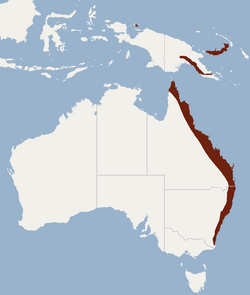| Golden-tipped bat | |
|---|---|
| Scientific classification | |
| Kingdom: | Animalia |
| Phylum: | Chordata |
| Class: | Mammalia |
| Order: | Chiroptera |
| Family: | Vespertilionidae |
| Genus: | Phoniscus |
| Species: | P. papuensis |
| Binomial name | |
| Phoniscus papuensis (Dobson, 1878) | |
 | |
| Synonyms | |
Kerivoula papuensis Dobson, 1878 | |
The golden-tipped bat (Phoniscus papuensis) is a species of Microchiropteran in the family Vespertilionidae. [2] It is found in Papua New Guinea and in Australia, especially scattered along the eastern part of Australia. [3] The species is considered uncommon, [4] and is listed as endangered in Australia. [5]
